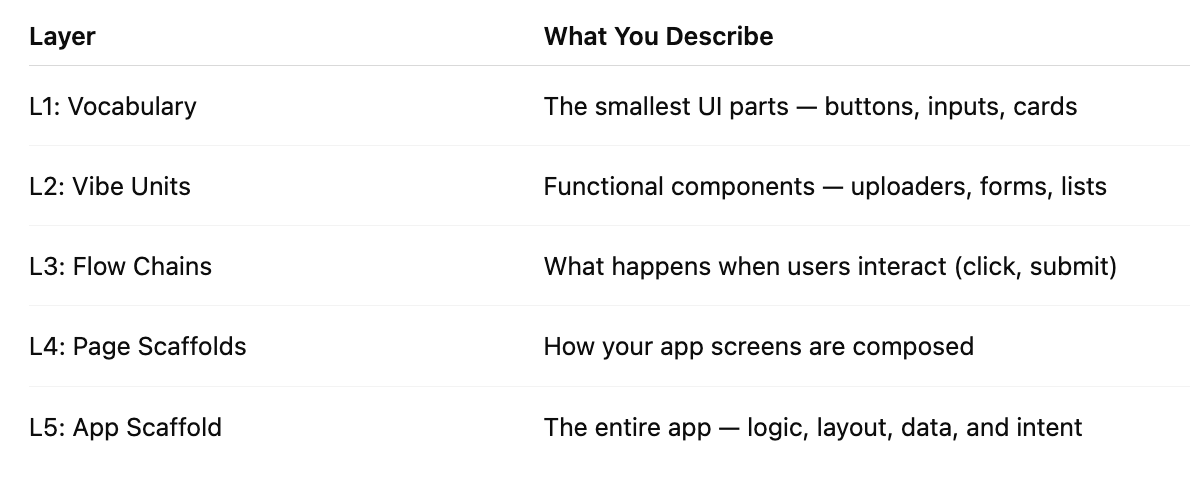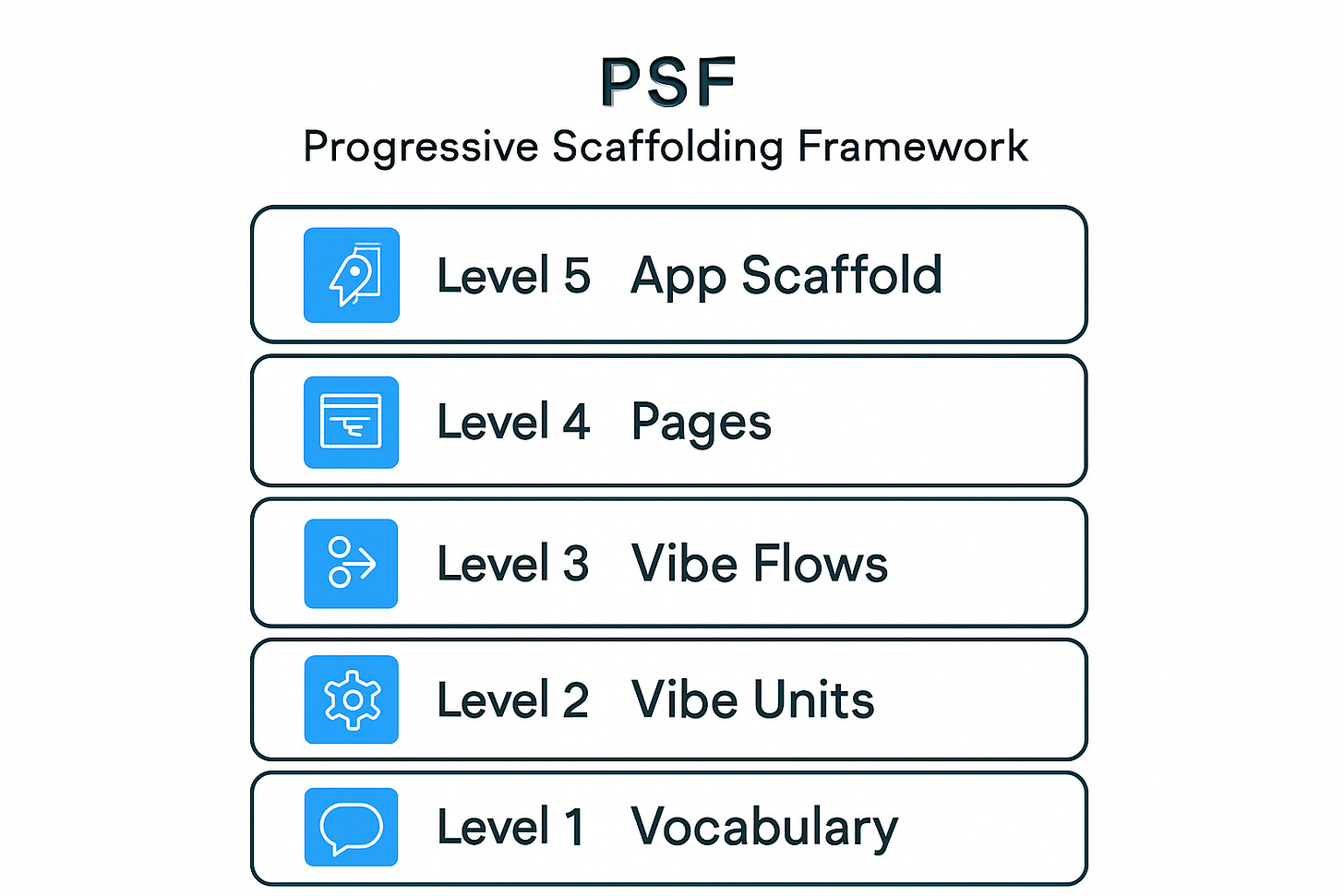The Only Mental Model You Need to Vibe Code Like a Product Thinker
How the Progressive Scaffolding Framework Helps You Think in Layers, Speak in Prompts, and Build Real Apps
Prompt First, Build Fast: A Personal Journey Through the New Era of Software Creation
Seventeen years ago, I started my career designing websites — basic HTML, a bit of CSS, and JavaScript magic when I felt ambitious. Back then, shipping a working site felt like making fire with sticks: rewarding, but tedious. Over time, the tech stack exploded. Suddenly, being a “web developer” meant mastering a dizzying array of frameworks, build systems, API integrations, databases, authentication schemes, and deployment orchestration. The barrier between idea and execution didn’t shrink — it grew wider, more complex, and more exclusive.
I’m not alone in feeling this. Even Andrej Karpathy, one of the leading voices in the LLM-powered AI revolution, recently said:
“It's a bit like assembling IKEA furniture. There's no ‘full-stack’ product with batteries included; you have to piece together and configure many individual services.”
Now that AI is taking over larger parts of the software development process, according to the very people building the underpinning models that power it, the way we build has changed dramatically.
CodeGen platforms and AI-assisted coding tools are launching almost weekly these days. They promise to empower anyone to create real, modern web and mobile applications — without wrestling through the usual boilerplate, wiring, and setup headaches that once blocked newcomers.
But here’s the twist: even with all this AI magic, the core problem hasn’t disappeared.
Especially for newcomers. Even with the best tools, they encounter the same obstacle — not a technical issue, but a lack of conceptual clarity.
For experienced devs, the issue is control — being unable to finesse every detail.
For non-technical builders, the issue is clarity — understanding what the AI is actually doing and how to ask for it clearly.
This isn’t about syntax. It’s about structure. It's about understanding how apps actually work.
How do I describe what I want the app to do?
What happens when someone clicks a button?
Where does the data go?
What should be on the screen — and why?
These are the questions that matter before you start prompting. These are the questions most CodeGen platforms don't teach you how to ask.
And the truth is, it’s not fair to expect non-techies to magically know how to "speak developer" while also having product intuition and UI taste. That’s a tall order — even for pros (okay, maybe juniors).
From Syntax to Structure: My 800+-Hour Pivot
Nearly two decades of building websites have taught me a lot. But none of it prepared me-or anyone (I feel like I am not alone in this), really, for the paradigm shift now unfolding.
Vibe Coding.
Vibe Coding is a new way of programming where you describe what you want in natural language and the AI builds it for you. Instead of writing code line by line, you work alongside AI-assisted coding tools and CodeGen platforms that translate intent into running software. You think and communicate like a designer of logic — describing structure, behavior, and purpose — while the system handles implementation details. It’s not about writing code by hand; it’s about directing creation through dialogue with the machine.
That is what I did for the last three months, despite my peers trashing even the idea of thinking about Vibe Coding.
I went all in.
For three months, I immersed myself in the new wave of AI-assisted development using CodeGen platforms such as Lovable and AI-assisted coding tools like Cursor and Github Copilot, which functions as an extension that can be integrated into the code writing application VSCode.
Ten hours a day. Nearly every day.
By the end of June, I’ll be nearing 1,000 hours of focused Vibe Coding.
And somewhere in that obsession, a deeper structure began to emerge — a way to scaffold ideas with clarity, one layer at a time.
I called it the Progressive Scaffolding Framework (PSF).
Layer by layer, it helped me describe and generate:
Atomic UI vocabulary
Functional units like uploaders, forms, and cards
Flow logic — what happens when users interact
Page layouts
Entire application scaffolds
And out of that structure came something even more powerful:
The One Prompt to Build Them All — a modular, remixable way to describe any product idea in clear, scaffold-aware language.
It turns out the problem isn’t with the tools; it’s a lack of clarity.
We’re in a golden age of tooling. CodeGen platforms can write code, manage versions, host your app, and even handle auth and database connections.
The AI-assisted coding platforms and tools have resolved the syntax issue, but the thinking problem persists. I don’t know about you, but relinquishing my agency in what I do to AI is a definite NO for me.
The challenge is knowing what you want your app to do — and how to describe that in a structured way.
That’s why I built the PSF. Not as another framework to memorize, but as a mental model. A way to scaffold your idea clearly, one layer at a time.
The Five Layers of Clarity: What the PSF Actually Does
The Progressive Scaffolding Framework (PSF) helps you move from vague ideas to buildable instructions, layer by layer.
Each layer builds on the one below it. You don’t start by asking AI to “build me an app like Duolingo.” You begin by describing what’s on the screen. Then what happens when someone interacts? Then what happens to the data? You scaffold — like a builder.
Sure, you can prompt, “Build me a Duolingo clone,” and get something back. But it’ll be generic. It won’t reflect your vision. And customizing it? You’ll need to speak to a developer — or else accept what the AI gives you. Slop, as some call it.
PSF changes that. It doesn’t just help you build faster. It helps you think better.
Prompting Isn’t Guesswork — It’s Composition
Here’s the mistake most people make with AI dev tools:
“Can you create a simple site where users can sign up for a newsletter?”
You’ll get something. But it’ll be off. Why? Because the prompt lacks structure. The AI has to guess.
Now try it with PSF thinking:
Let’s build a clean, focused landing page designed to grow a newsletter audience.
Its purpose is to capture emails with a simple form, build trust by showcasing past issues, and encourage interaction with clear structure and feedback.
Layout: a single-screen structure.
Top section: hero with a headline, subtext, and a call-to-action form.
Middle section: grid of past newsletters, displayed as cards with date, title, and tags.
Bottom section: footer with navigation links and social icons.
On form submission: validate input, store the email to Supabase, show a success toast, and clear the form fields.
Now the AI knows the zones, the functional units, and the logic flow. That’s the difference between prompting and composing.
Prompting should not be a matter of trial and error; it ought to be an orchestration.
Like handing a cameraman a shot list, or giving a jazz band sheet music to improvise from.
Enter the Builder Chain: Your Mental Checklist for Every App
The PSF also gives you a repeatable workflow — a Builder Chain that mirrors how real software comes together:
Vibe → Purpose — What’s the core idea and feel?
Frame → Layout — How is the interface structured?
Stack → Units — What functional blocks does it need?
Wire → Flows — What should happen when people interact?
Polish → Ship — How should it look, feel, and finish?
It’s not just a checklist. It’s a mental model for turning fuzzy ideas into structured software — one layer at a time.
Keep reading with a 7-day free trial
Subscribe to Vibe Coding to keep reading this post and get 7 days of free access to the full post archives.





